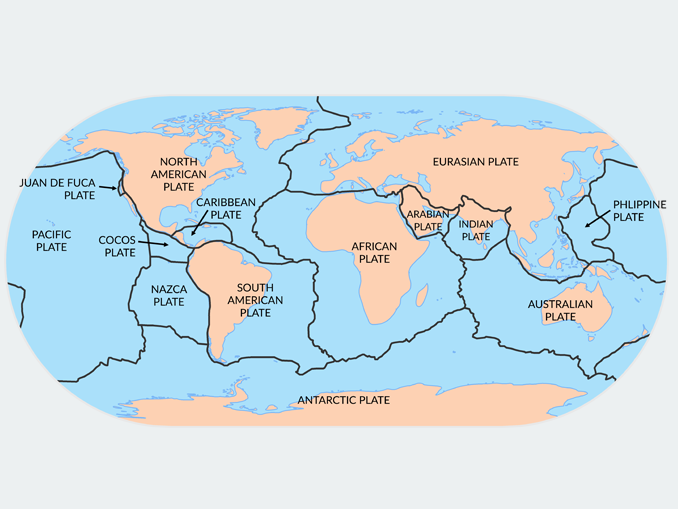Tectonic Plates and Plate Boundaries
Definition
History
List of tectonic plates
Components of a tectonic plate
Continent - Very large landmass identified by convention
Plate borders - Types of plate boundaries
Craton - Old and stable part of the continental lithosphere
Crust - The outermost solid shell of a rocky planet, dwarf planet, or natural satellite
Lithosphere - The rigid, outermost shell of a terrestrial-type planet or natural satellite That's defined by its rigid mechanical properties
Oceanic crust - The uppermost layer of the oceanic portion of a tectonic plate
Shield - A large stable place of exposed Precambrian crystalline rock
Supercontinent - Landmass comprising more than one continental core, or craton
Tectonic plate - Continuous portion of the lithosphere of the Earth that is moving relative to adjacent plates
Plate tectonics is the theory that Earth's outer shell is divided into several plates that glide over the mantle, the rugged inner layer over the core. The plates act like a tough and stiff shell in contrast to Earth's mantle. This powerful outer layer is called the lithosphere, which is 100 kilometers (60 miles) thick, according to Encyclopedia Britannica. The lithosphere includes the crust and outer part of the mantle. Below the lithosphere is that the asthenosphere, which is malleable or partly malleable, allowing the lithosphere to move around. The way that it moves around is an evolving notion.
History
Developed from the 1950s through the 1970s, plate tectonics is the contemporary version of continental drift, a theory first proposed by scientist Alfred Wegener in 1912. Wegener didn't have an excuse for how continents could move across the planet, but investigators do today. Before plate tectonics, individuals had to produce explanations of the geologic characteristics in their region that were unique to that particular region," Van der Elst said. "Plate tectonics coordinated all these descriptions and said that you should have the ability to explain all geologic characteristics as though pushed by the relative movement of those tectonic plates.
List of tectonic plates
There are nine main plates, according to World Atlas. These plates are called following the landforms located on them. The nine major dishes are North American, Pacific, Eurasian, African, Indo-Australian, Australian, Indian, South American and Antarctic. The biggest plate is the Pacific Plate in 39,768,522 square kilometers (103,000,000 square kilometers). Most of it's situated under the ocean. It's moving northwest at a rate of approximately 2.75 inches (7 cm) per year. Additionally, there are many smaller plates around the world.
Continent - Very large landmass identified by convention
Plate borders - Types of plate boundaries
Craton - Old and stable part of the continental lithosphere
Crust - The outermost solid shell of a rocky planet, dwarf planet, or natural satellite
Lithosphere - The rigid, outermost shell of a terrestrial-type planet or natural satellite That's defined by its rigid mechanical properties
Oceanic crust - The uppermost layer of the oceanic portion of a tectonic plate
Shield - A large stable place of exposed Precambrian crystalline rock
Supercontinent - Landmass comprising more than one continental core, or craton
Tectonic plate - Continuous portion of the lithosphere of the Earth that is moving relative to adjacent plates
Like many features on the planet's surface, plates alter over time. Those composed partly or completely of oceanic lithosphere can elongate under another plate, typically a lighter, largely continental plate, and finally disappear completely. This procedure is occurring now from the coast of Oregon and Washington. The little Juan de Fuca Plate, a remnant of the formerly much larger oceanic Farallon Plate, will be completely absorbed as it proceeds to sink under the North American Plate.


https://geology-hub.com/geology-forum-for-geologists/
ReplyDeleteGeology forum for geologists